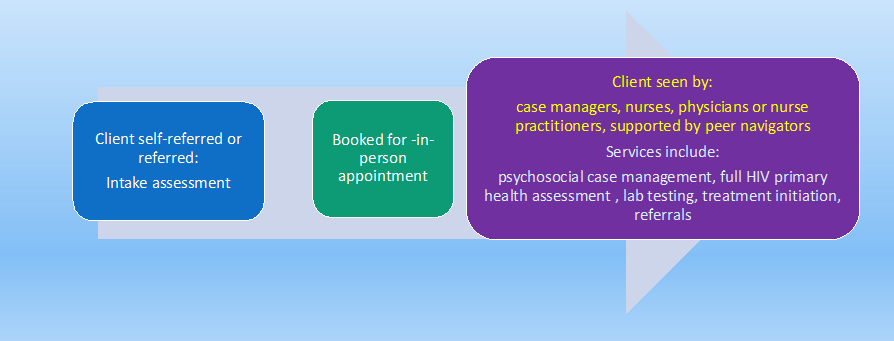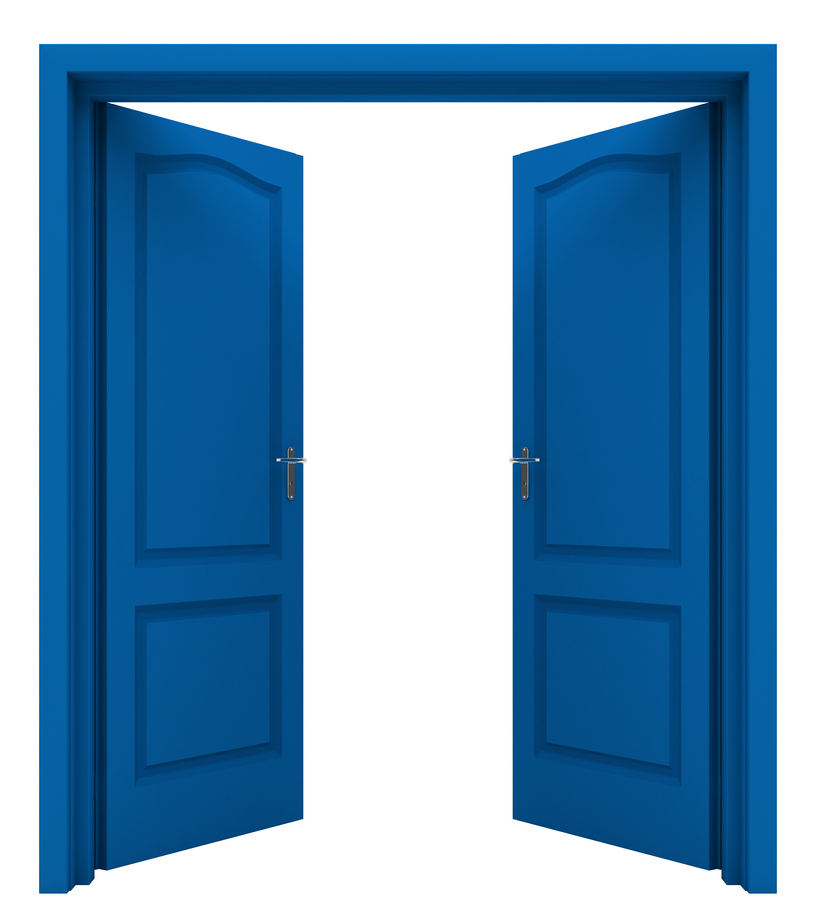What is the program?
The Blue Door Clinic provides short-term HIV treatment, ongoing community support and referrals to community and health services for people living with HIV who are precariously insured or uninsured in Ontario. The program then seeks to connect them to ongoing HIV primary care through a network of providers in the community. Precariously insured or uninsured people can include (among others) international students, people with expired work visas and migrant workers. The program also provides support and education to service providers (e.g., primary care providers) to build knowledge of the needs of precariously insured or uninsured people living with HIV and build capacity to deliver services to this population.
The Blue Door Clinic opened in August 2019 and leverages multi-sector collaborations to provide precariously insured or uninsured people with ongoing HIV treatment and care. The clinic was developed and supported by 11 collaborating partner organizations in Toronto: the Black Coalition for AIDS Prevention, Casey House, the Committee for Accessible AIDS Treatment (CAAT), Fife House, the Hassle Free Clinic, the Ontario HIV Treatment Network (OHTN), the Parkdale Queen West Community Health Centre (CHC), the Regent Park Community Health Centre, Sherbourne Health, The Centre for Spanish Speaking Peoples and the Toronto People With AIDS Foundation. The Regent Park CHC takes on the administration role for the network and provides the space for clinical care.
Why was the program developed?
The Blue Door Clinic opened in response to the observation by service providers in Toronto that there was an increase in the number of people who were being diagnosed with HIV but who had limited or no health insurance to access HIV treatment and care.
In addition, prior research from CAAT and ongoing feedback from community members identified gaps in linkage of precariously insured or uninsured populations to stable and ongoing primary care and difficulties in their ability to access HIV treatment medications and laboratory testing and diagnostics as well as social support services (e.g., immigration services, legal support). Service users identified barriers including stigma and isolation, affordability of HIV treatment medications and language barriers. Service providers identified barriers including a lack of knowledge related to HIV treatment and care for this population, a lack of time for case management and a lack of clear referral pathways and/or billing pathways.
The idea for the Blue Door Clinic started with a discussion at an OHTN event in 2018. A group of community members and service providers then developed a working group to start planning services to address this need. The working group conducted a community needs assessment and focus groups with affected community members to co-develop a clinic service model (i.e., to identify an operational model, location and needed resources). Each of the partner organizations identified their expertise and the potential resources that they could contribute to the project to establish a network of relevant and needed services for community members.
How does the program work?
The Blue Door Clinic provides short-term care to people living with HIV who are precariously insured or uninsured. The program then seeks to connect people to ongoing primary and HIV care through a network of HIV primary care providers in the community. A member of a precariously insured or uninsured population can include (but is not limited to) a person who:
- has an expired visitor visa
- has an immigration application pending
- had a refugee claim rejected but has not been deported
- is a migrant worker with an expired work permit
- is an international student
The Blue Door Clinic is housed at the Regent Park CHC. This allows for the provision of services in a non-HIV specific service location and allows clients to access a full range of clinical services and be connected to a variety of services both within the CHC and within the wider community. People living with HIV who are precariously insured or uninsured can either self-refer or be referred by another agency to the Blue Door Clinic.
Upon referral to the program, an intake worker completes an assessment and triages clients on the basis of their needs. After intake, a client will be booked for an initial in-person visit at the Blue Door Clinic with the health care team (i.e., physician, nurse and case manager). During this visit, the healthcare team completes a physical and psychosocial assessment and baseline laboratory testing and coordinates access for HIV treatment. A pharmacist can help with obtaining compassionate access to medications if needed, as well as being part of the healthcare team that provides information and educational support to clients.
Following the initial in-person visit, clients can also be connected to a variety of other community-based services to help them navigate the health system and access various health and social services (e.g., immigrant and legal services, housing, HIV services and peer support) if they are interested and willing. Case managers, peer navigators and community workers all play a role in making referrals and assisting clients in connecting to services.
The clinic operates one day per week out of the Regent Park CHC, with phone and support services staffed by partner agency nurses and case managers in between clinic days to address any clinical needs that arise.
Key services provided by the Blue Door Clinic include:
- HIV primary care health services
- access to all needed diagnostic tests
- immunization and other preventive care
- support to access HIV treatment
- referral to primary care physicians, as well as infectious disease and other specialists as needed
- psychosocial, mental health, addictions and other community support
- case management support and referral to appropriate community services (e.g., legal and financial support, housing, food, psychosocial supports)
The program also relies on partnerships with a variety of organizations to refer clients to the Blue Door Clinic and to provide a referral pathway for Blue Door Clinic clients who require the services the partner organizations provide. In addition, staff for the Blue Door Clinic are provided through in-kind support from these partner organizations. For example, physicians and nurse practitioners are provided by the Regent Park CHC, the Parkdale Queen West CHC and the Hassle Free Clinic. Nurses are provided through Sherbourne Health and Casey House. Peer navigators are provided through the Toronto People With AIDS Foundation, and case managers and intake workers through Fife House, CAAT and Casey House.
The Blue Door Clinic provides health services to the client until they have been connected to an ongoing HIV primary care provider in the community (i.e., upon receipt of the request for the patient’s records from the new primary care provider). Case managers can continue to support clients upon discharge from the clinic as they transition to new providers through navigation supports (e.g., information to clients on how to continue accessing compassionate access HIV medications, connecting clients to a community-based HIV organization). Clients can also continue to access services of partner organizations for ongoing support (e.g., health navigation, interpretation services).
Education for primary care providers
In addition to services for people living with HIV who are precariously insured or uninsured, the Blue Door Clinic also builds the capacity of service providers (e.g., primary care providers) to serve this population through education and training opportunities.
Experienced service providers working with the Blue Door Clinic organize and plan education and training for other service providers who are interested in learning more about the population of people living with HIV who are precariously insured or uninsured. Continuing medical education (CME) accredited training, individual agency-based workshops and on-the-job mentoring support are organized by the multidisciplinary team (e.g., physicians, nurses, case managers and peer navigators) in response to specific requests and needs.
Frontline organizations connect with the Blue Door Clinic directly for education and training sessions for their staff. Education sessions are customized for the audience in attendance (e.g., primary care providers, broader health and social service providers). Education and training sessions are normally one-time and can be up to a day long.
In addition to information on what the Blue Door Clinic is and how it works, sessions have included topics such as:
- Understanding the needs of precariously insured people living with HIV and the barriers to care
- HIV primary care I: basic approach and treatment options
- System navigation and resource supports
- HIV primary care 2: preventive health screening and vaccination
Individual service providers can also request one-to-one training for staff (e.g., new physicians, nurses interested in working in this area) by connecting with the Blue Door Clinic. One-to-one mentoring can also be provided to providers who have committed to take on patients through the program. The topics included are determined by the service provider and team (e.g., how to prescribe HIV treatment medication, how to do appropriate referrals).
Required resources
- Nurses
- Prescribers: physicians and nurse practitioners
- Intake worker
- Clinical and administrative coordinator
- Case managers
- Peer navigators
- Outreach workers
- Pharmacists
- Clinic space
- Partnerships with and connections to community-based organizations for referrals
Evaluation
Oversight and evaluation of the program are done through:
- collection and review of service data by the steering committee
- regular case review meetings of the provider team
- the Beyond Blue Door research study, which uses mixed methods and a framework to evaluate the Reach, Effectiveness, Adoption, Implementation, & Maintenance (REAIM) of the program.
To date the Blue Door Clinic has served over 130 precariously insured or uninsured clients from diverse racial and cultural backgrounds and immigration and citizenship statuses. All clients (100%) have been supported to access needed HIV treatment and diagnostic tests. Since service inception, over 60% of clients have been successfully referred or connected to long-term stable HIV primary care; 30% remain in active care with the Blue Door Clinic at any given time.
Challenges
- The following occurred as a result of the COVID-19 pandemic:
- Gaps in service access increased (e.g., finding permanent primary care) due to a reduction in in-person service delivery.
- Service providers were redeployed to pandemic-related responses (e.g., vaccine clinics), leading to staffing gaps and turnover.
- There was an increase in mental health distress and uncertainty related to service access for clients.
- The need increased for navigation and support services to access community resources and referrals.
- The timeline with immigration and legal document processing was delayed.
- Linking clients to primary care physicians who are knowledgeable about HIV care and diverse insurance sources (e.g., insurance coverage for international students, the Interim Federal Health Program) is still a challenge because of limited physician capacity within the community.
- Physicians are declining patients because of a lack of interpretation capacity and a lack of resources to coordinate interpretation services and/or peer support.
- The ability to navigate other needed health and social services (e.g., mental health supports) continues to be a challenge for people who are precariously insured or uninsured, as does billing of health services for this population.
Lessons learned
- Limited frequency of in-person services (weekly clinic) still poses challenges and creates gaps for clients who need urgent follow-up in between clinic days.
- As the clinic works with a large pool of providers who change from week to week, it is critical that good communication systems and consistent core coordination support are in place to ensure continuity of care and good client care follow-up.
- Multiple partnerships and organizations are needed to serve the precariously insured and uninsured population and address their medical and psychosocial needs.
- Education on how to serve this population by and for service providers helps to reduce the barriers around service accessibility.
Program materials
- Blue Door Clinic Referral Form
- Workflow diagram

Contact information
The Blue Door Clinic
Located at Regent Park Community Health Centre
465 Dundas St E., 2nd Floor
Toronto ON M5A 2B2
https://www.bluedoorclinic.org
437-235-7423
Alan Li, MD
alanl@regentparkchc.org
Alessandro Bisignano, Intake Case Manager
abisignano@caseyhouse.ca
Simran Kaur, Intake Case Manager
skaur@fifehouse.org

